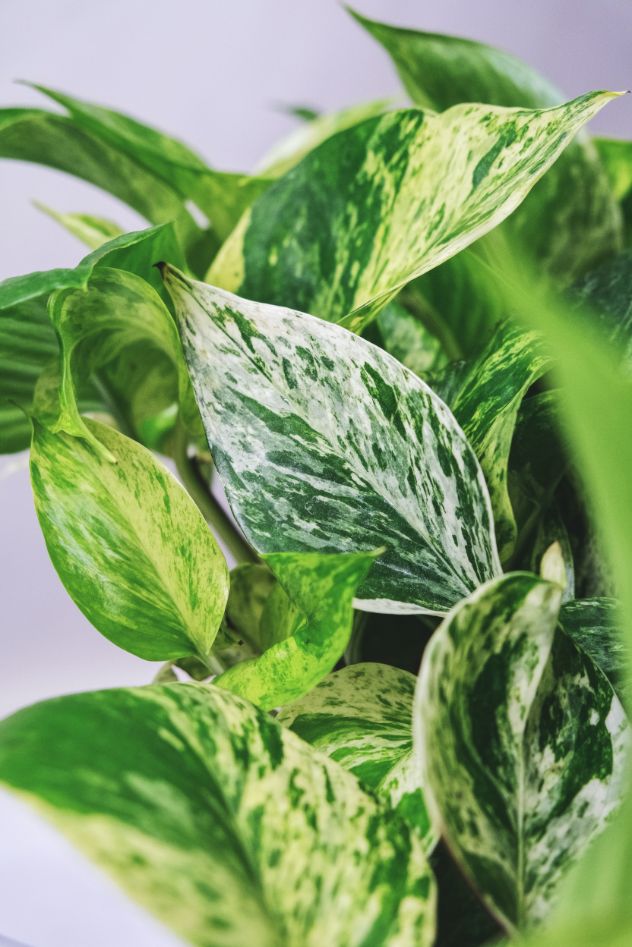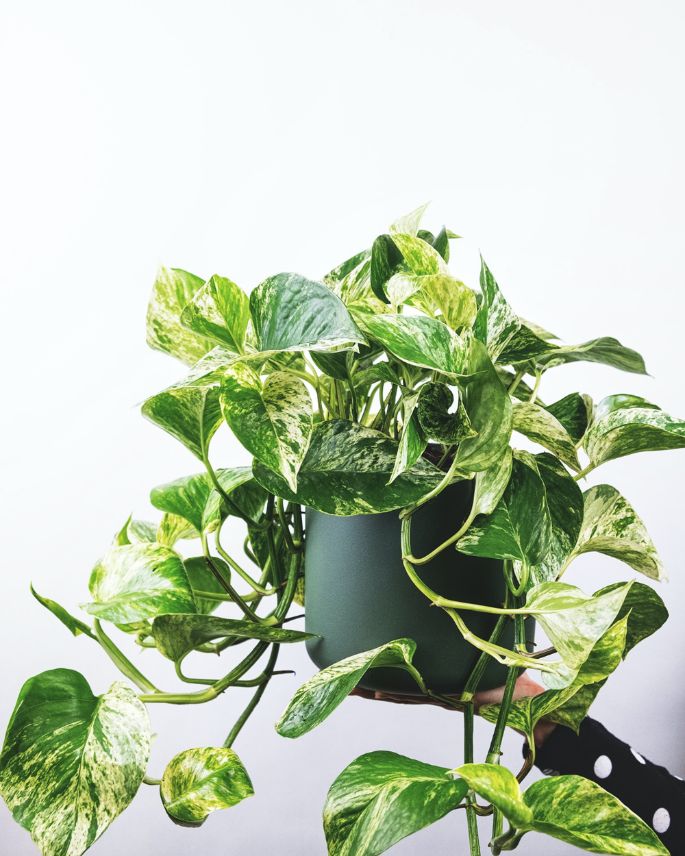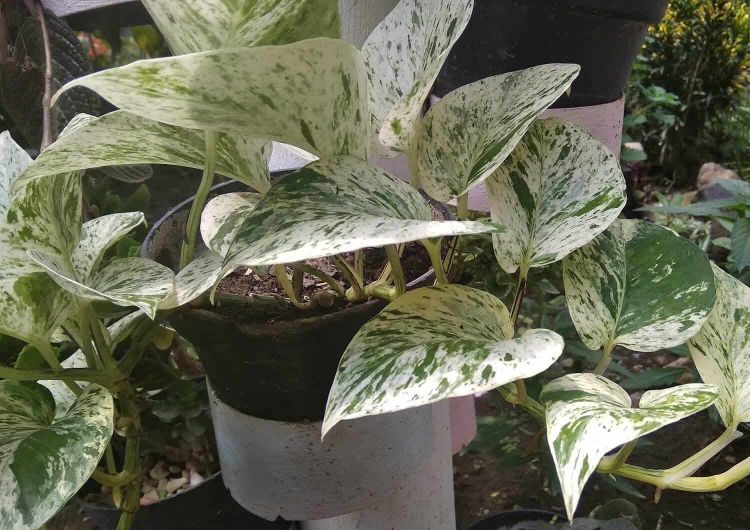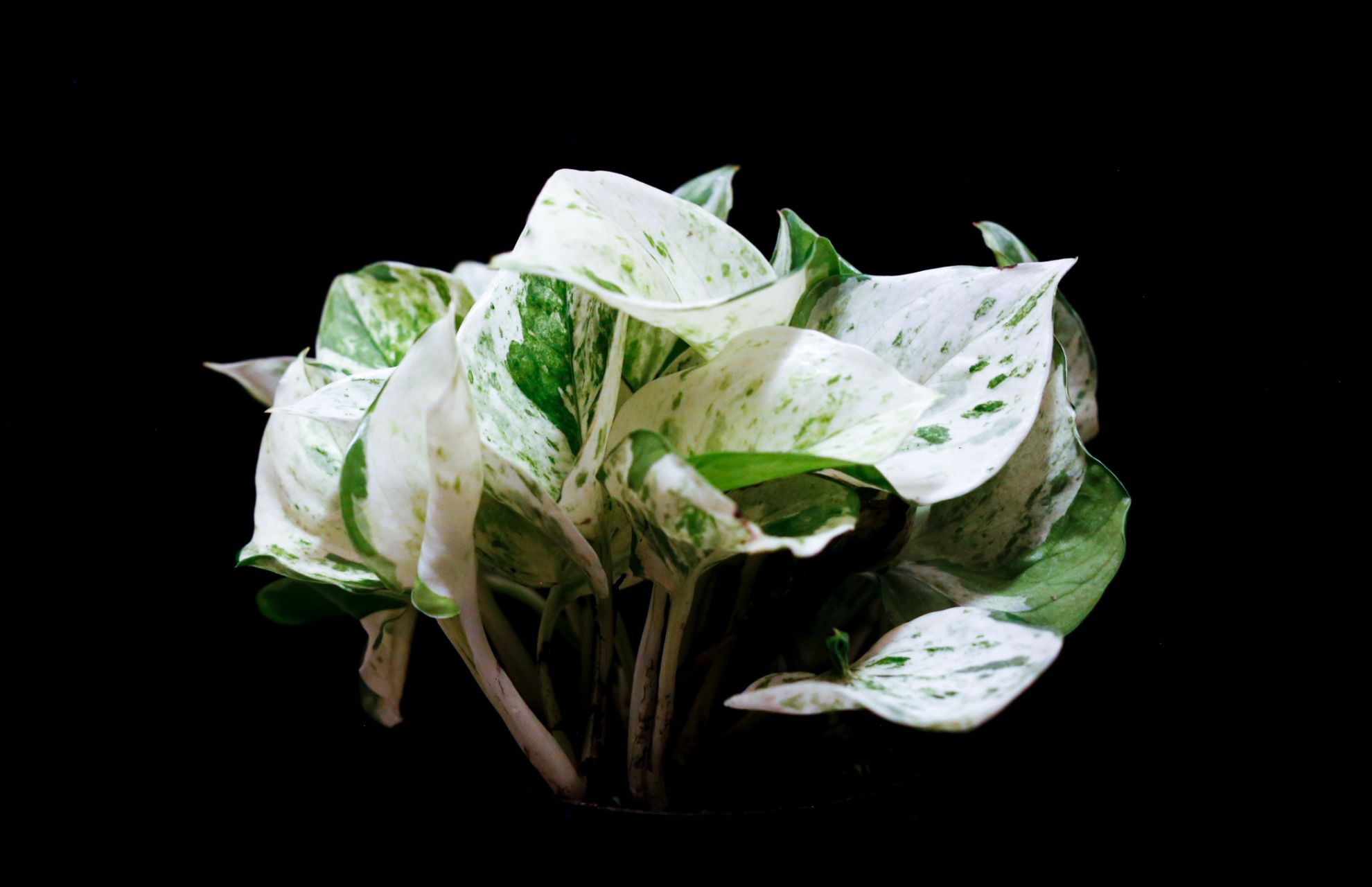A well-liked member of the pothos family is the marble queen. Long, cascading vines and eye-catching heart-shaped, green, and white variegated leaves are its standout features. It makes a beautiful trailing or hanging plant when supported by a high shelf or pot.
This tropical vining plant is tolerant of drought and isn’t particularly picky about the soil or light. The Marble Queen cultivar is also quite stunning, sporting lovely variegated leaves and vines that can trail up, down, or across any surface.
The Marble Queen Pothos is a speckled plant that is incredibly simple to care, which explains why both inexperienced and seasoned growers love it so much. You can learn how to take care of a Marble Queen pothos by reading this article.
About Marble Queen Pothos
Natural Habitat
Originally from French Polynesia, specifically the island of Moorea, Epipremnum aureum has spread to other tropical and subtropical areas of the world, including northern South Africa, Australia, Southeast Asia, South Asia, the Pacific Islands, and the West Indies.
Sri Lankan forests have been completely overrun by Epipremnum aureum, and it is now posing a threat to Hawaii and South Africa.
Luckily, Epipremnum aureum can be tamed at home, but it’s always wise to keep your plant from “escaping” into your yard (and into the environment) by properly disposing of your pothos clippings.
Description

Marble Queen is an evergreen aroid plant that develops in a vining manner, similar to other pothos varieties. Although it has roots in the ground, it climbs toward the light with the assistance of trees.
The Marble Queen cultivar has stunning impressionist-style light green leaves with fine cream mottling that are highly variegated.
Pothos is a small, heart-shaped houseplant with thin, usually under 10-foot-long vines that have small, heart-shaped leaves. However, pothos grows densely and heavily in the wild, with huge leaves and sometimes 20-foot-long vines!
It’s uncommon to see pothos bloom indoors, but it can occasionally produce small, rather unimpressive flowers that resemble any other aroid (such as Swiss cheese plants or African mask plants).
Pothos Made Of Marble Versus Golden Pothos
It’s simple to mistake Marble Queen and Golden Pothos for one another at first glance because they are two of the most popular cultivars of Epipremnum aureum.
Their variation is the main difference that can be seen. The Marble Queen pothos has much more delicate marbling on lighter green leaves. Golden pothos, on the other hand, has leaves that are primarily dark green with yellow splotches.
How To Care For Marble Queen Pothos?
Soil
The better the soil, the better your indoor plants will grow. When gardening in a small space, having healthy soil is especially crucial. Pick a potting mix with good drainage.
For your plants, pick a container that is the right size. Make sure the container has space for the roots of the plants you intend to grow. Consider drainage when selecting the ideal pot. You can add some pebbles to the bottom of your chosen pot if it lacks a drainage hole.
Your plant will grow larger in proportion to the size of the pot. Keep the pot on the smaller side because pothos prefers to have their roots bound.
Light And Temperature
Pothos is often recommended as a low-light or no-light plant to keep in the home because it isn’t overly picky about light, living up to its reputation as a low-maintenance houseplant. This is unquestionably the kind of plant to choose if you want to brighten a spot where most other plants would be uneasy.

Make sure your pothos is placed in a space with a moderate amount of natural light, even if it comes from a window on the opposite side of the room. The growth of your plant will be significantly slowed down by insufficient light, even though it can tolerate low light levels.
In order to keep producing its stunning variegated leaves, Marble Queen in particular requires a sufficient amount of sun. The plant might change back to green if the environment is too dark, which would allow it to photosynthesize more effectively.
Because of this, I advise positioning your Marble Queen close to a window. However, if you notice the leaves beginning to pale, that’s a sign your pothos is getting too much direct sun. With proper acclimation, it can withstand quite a bit of sun.
Marble Queen prefers temperatures that are similar to ours because it is a tropical plant. It cannot survive in temperatures below 55°F and does best in a range of 65°F to 85°F. Please avoid leaving the plant in a cold environment for an extended period of time as this will stunt its growth.
Water And Humidity
Again, pothos is a great choice for novice gardeners because it doesn’t require constant watering and thrives in slightly arid soil. Because pothos can withstand droughts pretty well, it’s okay if you forget to water your plant occasionally.
How can you tell when to water? Use your finger to feel the top few inches of the soil; if it feels dry, give it some water.
Pour fresh water over the plant slowly and lightly when watering. Allow the water to slowly drain out of the drainage hole and into the roots.
Many other common vining houseplants originate from tropical regions and thrive in high humidity, such as arrowhead plants and miniature Monsteras. Pothos like slightly higher than average indoor levels, and Marble Queen is no exception.
Your pothos should ideally reside in a space with a humidity range of 40% to 60%. (Checking the humidity in your home is simple with a low-cost digital humidity meter like this one.) Pothos enjoys being placed in windows-filled bathrooms or kitchens because it enjoys warmth and humidity.
Fertilizer
Expert gardeners may feel irrelevant when caring for marble pothos because they don’t have to worry about fertilizing this plant. Any all-purpose indoor plant fertilizer that is well-balanced will do. Safest is organic. From the spring to the fall, you can administer once a month.
Fertilizing becomes crucial if you want to grow Marble Pothos in water because, without it, the plant will grow too slowly.
The quantity of fertilizer you use will depend on the directions on the fertilizer’s box, the size of your plant, and the jar it will be placed in. In any case, all you need to do to stay safe is reduce the frequency and concentration by 50%.
If you want to go a bit more “pro” with your You can fertilize the soil for marble pothos at least once a month using compost or a liquid seaweed solution. This encourages foliage growth and gives the plant a bushier appearance.
Make sure to reduce the fertilizer’s concentration to half the recommended level once more, just to be safe. It is better to fertilize less than too much. Keep in mind that you should fertilize less during the winter and more during the growing season.
Pruning

Although pruning is not typically necessary for pothos, cutting the long vines aggressively every few months can keep your plant looking full and bushy. In the section on pothos propagation below, I go over how to easily start new plants using the stem tip clippings.
Dividing Or Repotting
Epipremnum aureum enjoys being a little root-bound and constrained in its pot. But if you notice the leaves drooping a lot (even after watering) and roots creeping out of the drainage hole, that likely indicates the plant is too rootbound, causing the soil to dry out too quickly.
For up to a year, most plants can thrive well in the pot they are supplied with. Feel the soil and note whether it is loose or tightly packed to determine when your plant probably needs to move to a larger pot. Your Epipremnum aureum may need to be repotted if it is very firm. To find out how to accomplish this, keep reading!
Common Problems With Marble Queen Pothos
Pothos With Browning Leaves
Any number of issues, including underwatering, overwatering, low humidity, sun damage, or cold damage, may be to blame for the browning of the leaves on your Marble Queen pothos.
To solve these common issues:
- Keep the soil just barely moist, and don’t let it get completely dry for more than a few days.
- If you tend to water plants excessively, use potting soil that is looser.
- Keep the plant away from drafty windows or heating vents, which can strip the air of humidity
- If the plant was previously housed in a dim area of your home, acclimate it to full sun.
- Remember that pothos is a tropical plant, so it won’t be content if the temperature regularly falls below 55°F.
Pothos With Brown Leaf Tips
If only the tips of the leaves are turning brown, there may be underwatering, low humidity, or poor-quality tap water to blame. If your pothos is too close to a window that receives harsh direct sunlight all day, this could occasionally be a sign of sun damage.
In the winter, dry air is probably to blame if you notice brown leaf tips. Consider moving your plant far from the fireplace, heater, or other heat sources.
Pothos With Yellowing Leaves
One of three things can cause the leaves on your pothos to turn yellow: either you overwater it, you don’t give it enough sunlight, or you don’t expose it to direct sunlight often enough.
It can be difficult to determine why your pothos is acting downcast because the causes of yellowing vary. To learn how to properly take care of your plant, scroll back up and read this guide once more.
Pothos With Droopy Leaves And Dry Soil
The time to water has passed too quickly, oops! Your plant will revive once you thoroughly water it. Try putting your plant in a less-lit or more humid area if you tend to forget things frequently so that it can retain moisture longer.
Pothos With Droopy Leaves And Moist Soil
It’s possible that you overwatered your pothos plant and caused the roots to rot, making it unable to absorb more water, if the leaves are still droopy despite your best efforts to water them.
If so, take out the plant, trim the rotted ends, and repot it in new potting soil (adding a small amount of perlite for better drainage).
Pothos With Bugs
Pothos is prone to pests like mealybugs, thrips, fungus gnats, and spider mites like any other houseplant. An insecticide can be used to get rid of these pests in a more natural way.
Tips To Keep Marble Queen Pothos Problem-free
These are some tips I’ve learned over the years for caring for Marble Pothos.
- Maintain a room temperature range of 65 to 90 degrees Fahrenheit.
When growing Marble Pothos, less is more. Avoid overfeeding or overwatering your plant. - Those Marble Pothos plants that receive only routine watering and little to no feeding will grow the best.
- When growing Marble Pothos in water, a liquid organic fertilizer performs better than a solid one. Keep it organic.
- If you want to grow Marble Pothos in tap water, make sure to de-chlorinate the water by exposing it to the sun for at least a day before you put your plant in it.
- For Marble Pothos to develop into a bushy shape, prune it frequently and replant the tip cutting back in the same container.
- Develop a number of vines in one pot.
Read More:
- Are Pothos Plants Toxic to cats and dogs, Dogs or Other Pets
- Brown Spots On Pothos Leaves: 8 Reasons & Solutions
- How To Grow And Care For Pearls And Jade Pothos?
- How To Propagate Pothos? 3 Methods
- What Is The Best Soil For Pothos? How To Choose?
- 10 Reasons Why Your Pothos Leaves Turning Yellow
- How To Grow And Care For Pearls And Jade Pothos?
- How Often To Water Pothos And How Much?
- How To Propagate Pothos In Water Easily And Quickly?








